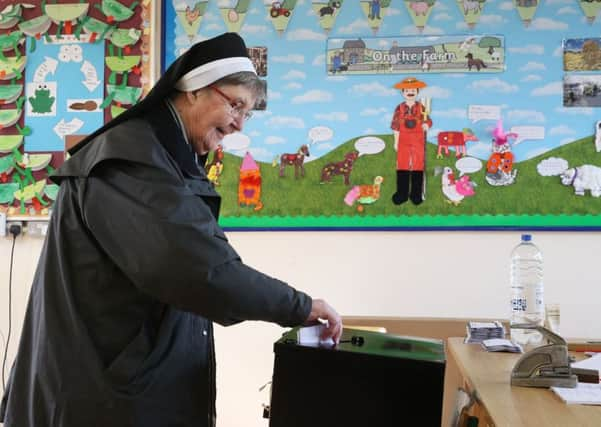Ireland votes amid austerity anger and threat of a hung parliament


Polling continued until 10pm throughout the country, with estimates putting the average turnout by late afternoon at around 30 per cent.
Rain-sodden parts of Co Cork saw a much slower stream of voters at polling stations during the day. Ireland’s president and leading politicians were among the first to cast their votes as the polls opened just before sunrise.
Advertisement
Hide AdAdvertisement
Hide AdAs the electorate increasingly turns away from mainstream parties to smaller factions and independents, a hung parliament is widely predicted.
President Michael D Higgins cast his vote near his official residence in Dublin’s Phoenix Park yesterday morning.
Outgoing Taoiseach and Fine Gael leader Enda Kenny voted in his home town of Castlebar, Co Mayo, while Tanaiste Joan Burton, the country’s deputy premier and leader of the Labour Party – Fine Gael’s junior partner in the last coalition government– voted in Dublin.
Fianna Fail leader Micheal Martin voted in his Cork constituency while Sinn Fein president Gerry Adams cast his ballot in Ravensdale, Co Louth, close to the border with Northern Ireland.
Such is the voter schism it threatens to blow apart a duopoly enjoyed for more than 80 years by the currently ruling Fine Gael party and the main Opposition party Fianna Fail.
Bitter rivals since Ireland’s civil war– despite little significant difference in their conservative policies– the pair who swapped power for generations may be forced into a historic “grand coalition”.
The coupling would have been unspeakable among their rank and file just years ago but is now hotly-tipped by pollsters and pundits as the odds-on favourite outcome.
The tectonic shift could also open a definitive right/left divide in Ireland’s parliament, the Dail, for the first time since the foundation of the state.
Advertisement
Hide AdAdvertisement
Hide AdOpinion polls show little chance of the outgoing Fine Gael/Labour coalition being returned to power on their own.
After five years of bruising austerity, Labour would need to defy predictions of big losses at the ballot box to help make up the numbers.
Other possibilities include a minority Fine Gael government, supported by arch-enemies Fianna Fail, or a rainbow coalition of Fine Gael, Labour and some smaller parties.
Once a clear picture emerges from the weekend counting of votes, the parties will have until 10 March – when the Dail is scheduled to resume– to forge a power-sharing deal.
The spectre of a second election will loom over any uncertainty.
Despite being the shortest general election campaign in Irish political history, it was a drawn-out, lacklustre three weeks that generally failed to ignite the imagination of the population.
Almost 3.3 million voters are eligible to cast their ballots, among them more than 30,000 who registered in time to vote this month.
More than 550 candidates are fighting in 40 constituencies for just 158 Dail seats.